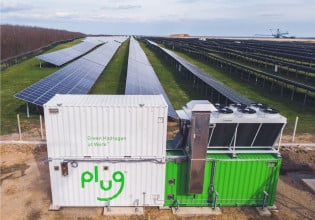Battery Energy Storage Systems Increase as Renewables Grow
As the use of renewable energy grows, grid systems are becoming increasingly dependent on battery storage.
Wind, solar, hydro, biomass, geothermal, and other renewable generation exceeded coal for the first time in 2022. In 2021, renewables surpassed nuclear power generation and continued to do so in 2022. In the U.S., the use of solar power on the electrical power grid grew from 61 gigawatts (GW) in 2021 to 71 GW in 2022, while wind power went from 133 GW to 141 GW in the same period. The U.S. Energy Information Administration (EIA) predicts 60 GW of solar will be added during 2023 and 2024.
Battery energy storage system used with renewable energy. Image used courtesy of NREL
Energy storage is one key to successfully integrating intermittent renewables into the power grid. Although pumped hydro has been used to store energy for decades, most recently, battery energy storage systems (BESSes) using lithium-ion batteries have become popular. As of the end of 2022, the total nameplate power capacity of operational utility-scale BESSes in the U.S. reached 8.842 GW, with an energy capacity of 11,105 megawatt-hours (MWh).
BESSes are poised to increase to meet demand as renewable energy sources grow.
The Rise of Battery Energy Storage Systems
According to a McKinsey and Company analysis, more than $5 billion was invested in BESSes in 2022, an almost threefold increase from the previous year. By 2030, the BESS market worldwide is predicted to reach between $120 and $150 billion.
Sites where energy storage systems are implemented. Image used courtesy of EIA
In 2022, the Inflation Reduction Act (IRA) allocated $370 billion to renewable energy projects. BESSes have been at the forefront of investments for applications like peak shaving, consumption optimization, and backup power for grid operators nationwide.
Factors Allowing Battery Energy Storage Growth
Several factors drive the rapid deployment of BESSes in the U.S. First, the increasing penetration of renewable energy sources has introduced challenges in grid management due to their intermittent nature. BESSes can effectively store excess renewable energy when production exceeds demand, ensuring a reliable and consistent electricity supply.
BESS capacity is expected to increase significantly. Image used courtesy of EIA
Second, advancements in battery technology have led to significant cost reductions and performance improvements. Lithium-ion batteries, the dominant technology for BESS applications, have seen a substantial price drop, making them more economically viable. Additionally, innovations in battery chemistry and manufacturing processes have enhanced these batteries' energy density and lifespan.
Third, supportive policies such as the IRA and other incentives are critical in promoting BESS adoption. Government programs, such as tax credits and rebates, have helped to offset the upfront costs of BESS installations, making them more attractive to investors and developers. Additionally, regulatory frameworks are evolving to recognize the value and potential of BESSes to enhance grid stability and reliability.
The Future of Battery Energy Storage
The U.S. Energy Information Administration has forecasted that in 2023, the energy sector will emit about 4,790 million metric tons of carbon dioxide (CO2). This is good news as it represents a 3% decrease from 2022. According to the EIA, much of this decrease can be attributed to lower electricity generation from coal-fired power plants brought about by higher generation from wind, solar, and other renewable sources. The EIA says that the trend is expected to continue into 2024 and predicts that CO2 emissions will decline by 1% relative to 2023.
The deployment of BESSes in the U.S. is expected to continue rapidly in the coming years. The EIA projects that utility-scale BESS capacity will reach 14 GW by 2025 and 30 GW by 2030. The expansion of renewable energy sources will drive this growth, in addition to the need for grid flexibility and resilience and the ongoing cost reductions and performance improvements in battery technologies.
BESSes are poised to transform the U.S. energy landscape, providing a range of benefits that will shape the future of electricity generation and distribution. Electrification of nearly everything presents one of the only practical ways to address climate change. When integrating renewable energy sources is enabled, enhancing grid reliability and reducing emissions, BESSes create a more sustainable and resilient energy system.









